Students must start practicing the questions from CBSE Sample Papers for Class 12 Accountancy with Solutions Set 1 are designed as per the revised syllabus.
CBSE Sample Papers for Class 12 Accountancy Set 1 with Solutions
Time :3 hrs
Max. Marks: 80
Instructions:
- This question paper contains 34 questions. All questions are compulsory.
- This question paper is divided into two parts, Part A and B.
- Part-A has Accounting for Partnership Firms and Companies.
- Part-B has Analysis of Financial Statements.
- Questions Nos. 1 to 16 and 27 to 30 carries 1 mark each.
- Questions Nos. 17 to 20, 31 and 32 carries 3 marks each.
- Questions Nos. from 21, 22 and 33 carries 4 marks each
- Questions Nos. from 23 to 26 and 34 carries 6 marks each
-
There is no overall choice. However, an internal choice has been provided in 7 questions of
one mark, 2 questions of three marks, 1 question of four marks and 2 questions of six marks.
Part – A
(Accounting for Partnership Firms and Companies)
Question 1.
A and B are partners sharing profits and losses in the ratio of 3 : 2. C is admitted for 1/4th and for which 30,000 and 10,000 are credited as a premium for goodwill to A and B respectively. The new profit sharing ratio of A : B : C will be ……………… [1]
(a) 3 : 2 : 1
(b) 12 : 8 : 5
(c) 9 : 6 : 5
(d) 33 : 27 : 20
Answer:
(d) Sacrificing ratio of A and B
\(A=\frac{3}{4} \times \frac{1}{4}=\frac{3}{16} ; \quad B=\frac{1}{4} \times \frac{1}{4}=\frac{1}{16}\)
Partner’s New Share = Partner’s Old Share + Partner’s Sacrificed Share
A’s new share \(=\frac{3}{5}-\frac{3}{16}=\frac{33}{80}\)
B’s new share \(=\frac{3}{5}-\frac{3}{16}=\frac{33}{80}\)
C’s new share \(=\frac{1}{4} \times \frac{20}{20}=\frac{20}{80}\)
Question 2.
Assertion (A) Batman, a partner in a firm with four partners has advanced a loan of 50,000 to the firm for last six months of the financial year without any agreement. He claims an interest on loan of 3,000 despite the firm being in loss for the year. Reason (R) In the absence of any agreement/provision in the partnership deed, provisions of Indian Partnership Act, 1932 would apply. [1]
Alternatives
(a) Both Assertion (A) and Reason (R) are true and Reason (R) is the correct explanation of Assertion (A)
(b) Both Assertion (A) and Reason (R) are true, but Reason (R) is not the correct explanation of Assertion (A)
(c) Assertion (A) is true, but Reason (R) is false
(d) Assertion (A) is false, but Reason (R) is true
Reason (R) In the absence of any agreement/provision in the partnership deed, provisions of Indian Partnership Act, 1932 would apply.
Alternatives
(a) Both Assertion (A) and Reason (R) are true and Reason (R) is the correct explanation of Assertion (A)
(b) Both Assertion (A) and Reason (R) are true, but Reason (R) is not the correct explanation of Assertion (A)
(c) Assertion (A) is true, but Reason (R) is false
(d) Assertion (A) is false, but Reason (R) is true
Answer:
(a) Both Assertion (A) and Reason (R) are true and Reason (R) is the correct explanation of Assertion (A)
![]()
Question 3.
If 10,000 shares of 10 each were forfeited for non-payment of final call money of 3 per share and only 7,000 of these shares were re-issued @ 11 per share as fully paid up, then what is the minimum amount that company must collect at the time of re-issue of the remaining 3,000 shares? [1]
(a) 21,000
(b) 9,000
(c) 16,000
(d) 30,000
Answer:
(b) Profit on forfeiture of 3000 shares = 3ooo x 7 = ₹ 21,000
Minimum reissue amount on 3,000 shares =(3000 x 10) — 21,000 = ₹ 9,000
Or
On 1st April 2022, Galaxy Ltd. had a balance of 8,00,000 in securities premium account. During the year company issued 20,000 equity shares of 10 each as bonus shares and used the balance amount to write off loss on issue of debenture on account of issue of 2,00,000, 9% debentures of 100 each at a discount of 10% redeemable @ 5% premium.
The amount to be charged to statement of profit and loss for the year for loss on issue of debentures would be
(a) 30,00,000
(b) 22,00,000
(c) 24.00,000
(d) 20,00,000
Answer:
(c) Remaining securities premium after bonus issue = 800000—2,00,000 = ₹ 6,00,000
Loss on issue of debentures = (2,00,000 x 10) + (2,00,000 x 5) = 20,00,000 + 10,00,000 = ₹ 30,00,000
T amount charged on the statement of profit and loss = 30,00,000 — 00,000 = ₹ 24,00,000
![]()
Question 4.
A, B and C who were sharing profits and losses in the ratio of 4: 3 : 2 decided to share the future profits and losses in the ratio to 2 : 3 : 4 with effect from 1st April, 2023. An extract of their balance sheet as at 31st March, 2023 is ….[1]

At the time of reconstitution, a certain amount of claim on workmen compensation was determined for which B’s share of loss amounted to 5,000. The claim for workmen compensation would be
(a) 15,000
(b) 70,000
(c) 50,000
(d) 80,000
Answer:
(d) Revaluation loss =5,000 × \(\frac{9}{3}\)=₹ 15,000
Outstanding workmen claim transferred to revaluation account =₹ 15,000
Total workmen claim = 65,000 + 15,000 =₹ 80,000
Or
A, B and C are in partnership business. A used ₹ 2,00,000 belonging to the firm without the information to other partners and made a profit of ₹ 35,000 by using this amount. Which decision should be taken by the firm to rectify this situation?
(a) A need to return only ₹ 2,00,000 to the firm
(b) A is required to return ₹ 35,000 to the firm
(c) A is required to pay back ₹ 35,000 only equally to B and C
(d) A need to return ₹ 2,35,000 to the firm
Answer:
(d) A need to return ₹ 2,35,000 to the firm
![]()
Question 5.
Interest on partner’s loan is credited to [1]
(a) partner’s fixed capital account
(b) partner’s current account
(c) partner’s loan account
(d) partner’s drawings account
Answer:
(c) partner’s loan account
Question 6.
Alexa Ltd. purchased building from Siri Ltd for ₹ 8,00,000. The consideration was paid by issue of 6 % debentures of ₹ 100 each at a discount of 20%. The 6% debentures account is credited with [1]
(a) 10,40,000
(b) ₹ 10,00,000
(c) ₹ 9,60,000
(d) ₹ 6,40,000
Answer:
(b) 6 % debentures amount =10,000 x 100 = ₹ 10,00,000; Number of debentures = \(\frac{8,00,000}{80}\) = 10,000 debentures
Or
Which of the following statements is incorrect about debentures?
(a) Interest on debentures is an appropriation of profits
(b) Debenture holders are the creditors of a company
(c) Debentures can be issued to vendors at discount
(d) Interest is not paid on debentures issued as collateral security
Answer:
(a) Interest on debentures is an appropriation of profits
![]()
Question 7.
Assertion (A) A company is registered with an authorised capital of 5,00,000 equity shares of ₹ 10 each of which 2,00,000 equity shares were issued and subscribed. All the money had been called up except ₹ 2 per share which was declared as ‘reserve capital’. The share capital reflected in balance sheet as ‘subscribed and fully paid up’ will be zero. Reason (R) Reserve capital can be called up only at the time of winding up of the company. [1]
Alternatives
(a) Both Assertion (A) and Reason (R) are true and Reason (R) is the correct explanation of Assertion (A)
(b) Both Assertion (A) and Reason (R) are true, but Reason (R) is not the correct explanation of Assertion (A)
(c) Assertion (A) is false, but Reason (R) is true
(d) Assertion (A) is true, but Reason (R) is false
Answer:
(a) Both Assertion (A) and Reason (R) are true and Reason (R) is the correct explanation of Assertion (A)
Question 8.
G, S and T were partners sharing profits in the ratio 3: 2: 1. G retired and his dues towards the firm including capital balance, accumulated profits and losses share, revaluation gain amounted to ₹ 5,80,000. G was being paid ₹ 7,00,000 in full settlement. For giving that additional amount of ₹ 1,20,000, S was debited for ₹ 40,000. Determine good will of the firm. [1]
(a) ₹ 1,20,000
(b) ₹ 80,000
(c) ₹ 2,40,000
(d) ₹ 3,60,000
Answer:
(c) Gaining ratio of \(T=\frac{1}{3}\)
Amount of G’s goodwill paid by T=₹ 80,000; Goodwill of the firm =80,000 x \(\frac{3}{1}\) = ₹ 2,40,000
Or
Annu, Banu and Chanu are partners, Chanu has been given a guarantee of minimum profit of ₹ 8,000 by the firm. Firm suffered a loss of ₹ 5,000 during the year. Capital account of Banu will be …… by ……….
(a) credited, ₹ 6,500
(b) debited, ₹ 6,500
(c) credited, ₹ 1,500
(d) debited, ₹ 1,500

![]()
Direction Read the following hypothetical situation and answer the Q. No. 9 and 10 on the basis of the given information. Richa and Anmol are partners sharing profits in the ratio of 3: 2 with capitals of ₹ 2,50,000 and ₹ 1,50,000 respectively. Interest on capital is agreed @ 6% p.a. Anmol is to be allowed an annual salary of ₹ 12,500. During the year ended 31st March, 2023, the profits of the year prior to calculation of interest on capital but after charging Anmol’s salary amounted to ₹ 62,000. A provision of 5% of this profit is to be made in respect of manager’s commission. Following is their profit and loss appropriation account
Answer:
(b) Total loss =8,000+5,000=13,000
The loss will be bear by Annu and Banu equally
Banu’s capital A/c will be debited by 13,000 x \(\frac{1}{2}\)=₹ 6,500
Question 9.
The amount to be reflected in blank (i) will be ………………….. [1]
(a) ₹ 37,200
(b) ₹ 44,700
(c) ₹ 22,800
(d) ₹ 20,940
Answer:

Question 10.
The amount to be reflected in blank (ii) will be ………………. [1]
(a) ₹ 62,000
(b) ₹ 74,500
(c) ₹ 71,400
(d) ₹ 70,775
Answer:
(c) ₹ 71,400
![]()
Question 11.
In the absence of an agreement, partners are entitled to …………….. [1]
(i) profit share in capital ratio.
(ii) commission for making additional sale.
(iii) interest on loan and advances by them to the firm.
(iv) salary for working extra hours.
(v) interest on capital.
Codes
(a) (i), (iv) and (v)
(b) (ii) and (iii)
(c) Only (iii)
(d) (i) and (iii)
Answer:
(c) Only (iii)
Question 12.
Rancho Ltd. took over assets worth ‘ 20,00,000 from PK Ltd. by paying 30% through bank draft and balance by issue of shares of 100 each at a premium of 10%. The entry to be passed by Rancho Ltd. for settlement will be ….. [1]
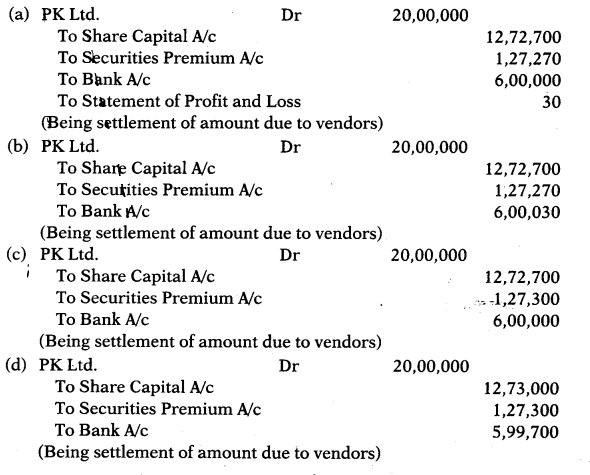
Answer:
(b) Issue price of shares =₹ 110
Number of shares issued \(=\frac{(20,00,000-6,00,000)}{110}\)=12,727.27 shares
Since the company cannot issue shares in fractions, 0.27 shares will be paid though the bank.
0.27 x 110=₹ 30 (approx.)
Payment through bank =6,00,000+30 = ₹ 6,00,030
![]()
Question 13.
A company forfeited 3,000 shares of ₹ 10 each, on which only ₹ 5 per share (including ₹ 1 premium) has been paid. Out of these few shares were re-issued at a discount of ₹ 1 per share and ₹ 6,000 were transferred to capital reserve. How many shares were re-issued? [1]
(a) 3,000 shares
(b) 1,000 shares
(c) 2,000 shares
(d) 1,500 shares
Answer:
(c) 2,000 shares
Question 14.
X and Y are partners in a firm with capital of ₹ 18,000 and ₹ 20,000. Z brings ₹ 10,000 for his share of goodwill and he is required to bring proportionate capital for 1/3rd share in profits. The capital contribution of Z will be……… [1]
(a) ₹ 24,000
(b) ₹ 19,000
(c) ₹ 12,667
(d) ₹ 14,000
Answer:
(a) Total capital of old partners (after adjustment of goodwill) =23,000+25,000=₹ 48,000
New Firm’s Capital = Total Adjusted Capital x Reverse of Remaining Share
Let the profits be ₹ 1. Remaining share =1-\(\frac{1}{3}=\frac{2}{3}\)
New firm’s capital =48,000 x \(\frac{3}{2}\) = ₹ 72,000
Z’s capital =72,000 x \(\frac{1}{3}\) = ₹ 24,000
Question 15.
A and B are partners. B draws a fixed amount at the end of every quarter. Interest on drawings is charged @ 15% p.a. At the end of the year interest on B’s drawings amounted to ₹ 9,000. Drawings of B were …………… [1]
(a) ₹ 24,000 per quarter
(b) ₹ 40,000 per quarter
(c) ₹ 30,000 per quarter
(d) ₹ 80,000 per quarter
Answer:
(b) Interest on Drawings = Drawings x Rate x \(\frac{\text { Average Period }}{12}\)
9,000 =Drawings x \(\frac{15}{100} \times \frac{4.5}{12}\)
Drawings = ₹ 1,60,000
Or
Shyam, Gopal and Arjun are partners carrying on garment business. Shyam withdrew ₹ 10,000 in the beginning of each quarter. Gopal, withdrew garments amounting to ₹ 15,000 to distribute it to flood victims, and Arjun withdrew ₹ 20,000 from his capital account. The partnership deed provides for interest on drawings @ 10% p.a. The interest on drawing charged from Shyam, Gopal and Arjun at the end of the year will be
(a) Shyam ₹ 4,800; Gopal ₹ 1,000; Arjun ₹ 2,000
(b) Shyam ₹ 4,800; Gopal ₹ 1,000; Arjun ₹ 2,000
(c) Shyam ₹ 2,500; Gopal ₹ 750; Arjun-Nil
(d) Shyam ₹ 4,800; Gopal-Nil; Arjun-Nil
Answer:
(c) Interest on Shyam’s capital =40,000 x \(\frac{10}{100} \times \frac{7.5}{12}\) = ₹ 2,500
Interest on Gopal’s capital =15,000 \(\times \frac{10}{100} \times \frac{6}{12} \) = ₹ 750
Interest on drawings is charged on drawings out of profit only, so it will not be charged on Arjun’s drawings since he has withdrawn from his capital.
Question 16.
On the day of dissolution of the firm ‘Roop Brothers’ had partner’s capital amounting to ₹ 1,50,000, external liabilities ₹ 35,000, cash balance ₹ 8,000 and profit and loss (debit) ₹ 7,000. If realisation expense and loss on realisation amounted to ₹ 5,000 and ₹ 25,000 respectively, the amount realised by sale of assets is……….. [1]
(a) ₹ 1,64,000
(c) ₹ 1,57,000
(b) ₹ 1,45,000
(d) ₹ 1,50,000
Answer:
(d) Book Value of the Assets (except cash) = Capital + Liabilities – Profit and Loss Account – Cash
= 1,50,000 + 35,000 – 7,000-8,000 = ₹ 1,70,000
Amount realised by sale of assets = 1,70,000+5,000 – 25,000 = ₹ 1,50,000
![]()
Question 17.
Anshul, Babita and Chander were partners in a firm running a successful business of car accessories. They had agreed to share profits and losses in the ratio of 1/2: 1/3: 1/6 respectively. After running business successfully and without any disputes for 10 years, Babita decided to retire due to old age and the Anshul and Chander decided to share future profits and losses in the ratio of 3: 2. ………… [3]
The accountant passed the following journal entry for Babita share of goodwill and missed some information. Fill in the missing figures in the following Journal entry and calculate the gaining ratio.
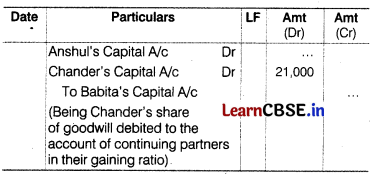
Answer:
Gaining Ratio = New Ratio – Old Ratio
Anshul’s gaining ratio =\(\frac{3}{5}-\frac{3}{6}=\frac{3}{30}\) ;
Chander’s gaining ratio =\(\frac{2}{5}-\frac{1}{6}=\frac{7}{30} \);
Gaining ratio =3: 7
Chander’s Share of Goodwill = Babita’s Share in Goodwill \times Chander’s Gaining Share
21,000 = Babita’s share in goodwill x \( \frac{7}{10}\)
Babita’s share in goodwill =21,000 x \(\frac{10}{7}\) = ₹ 30,000 ;
Anshul’s share =30,000 x \(\frac{3}{10}\)=₹ 9,000

Question 18.
R Q and R were partners with fixed capital of 40,000, 32.000 and 24.000. After distributing the profit of 48,000 for the year ended 31st March, 2022 in their agreed ratio of 3: 1 : 1, it was observed that …… [3]
(i) Interest on capital was provided at 10% p.a. instead of 8% p.a.
(ii) Salary of 12,000 was credited toP instead of Q.
You are required to pass a single jouraal entry in the beginning of the next year to rectify the above omissions.
Answer:
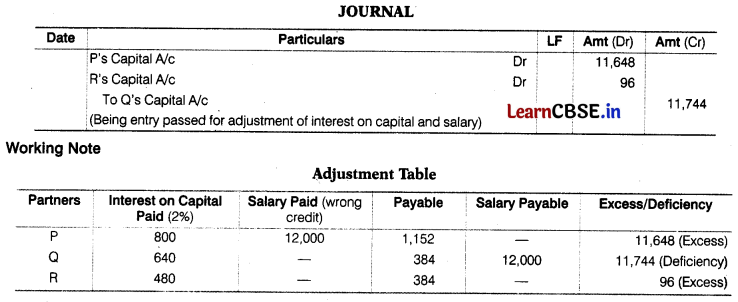
Or
Cheese and Slice are equal partners. Their capitals as on 1st April, 2022 were ₹ 50,000 and ₹ 1,00,000 respectively. After the accounts for the financial year ending 31st March, 2023 have been prepared, it is observed that interest on capital @ 6 % per annum and salary to Cheese @ ₹ 5,000 per annum, ds provided in the partnership deed has not been credited to the partners’ capital accounts before distribution of profits. You are required to give necessary rectifying entries using profit and loss adjustment account.
Answer:
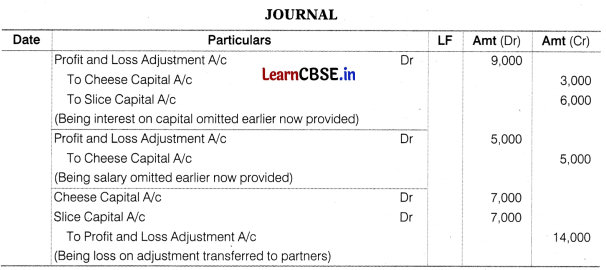
![]()
Question 19.
Pioneer Fitness Ltd. took over the running business of Healthy World Ltd. having assets of ₹ 10,00,000 and liabilities of ₹ 1,70,000 by…………. [3]
(i) Issuing 8,000, 8% Debentures of ₹ 100 each at 5 % premium redeemable after 6 years @ ₹ 110, and
(ii) Cheque for ₹ 50,000.
Pass the journal entries in the books of Pioneer Fitness Ltd.
Or
Lilly Ltd. forfeited 100 shares of ₹ 10 each issued at 10 % premium (₹ 8 called up) on which a shareholder did not pay ₹ 3 of allotment (including premium) and first call of ₹ 2. Out of these 60 shares were reissued to Ram as fully paid for ₹ 8 per share and 20 shares to Suraj as fully paid up @ ₹ 12 per share at different intervals of time. Prepare share forfeiture account.
Answer:
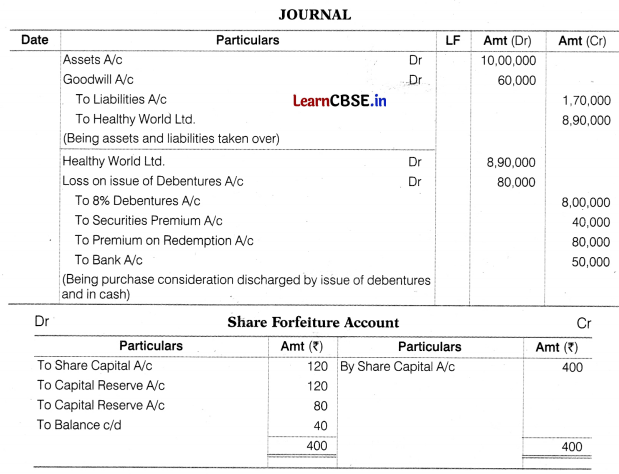
Question 20.
Calculate good will of a firm on the basis of three years purchases of the weighted average profits of the last four years. The profits of the last four years were [4]

Free
(ii) For the ‘purpose of calculating good will be corn any decided that the years ending 31st March, 2020 and 31st March, 22 I be weighted as I each (being Cod affected) and for year ending 31st March. 2022 and 31st March, 202 weights be taken as 2 and 3 respectively.
Answer:
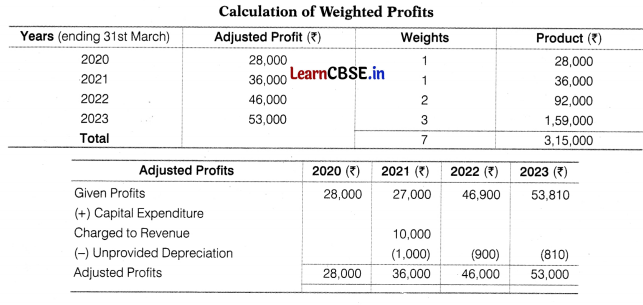
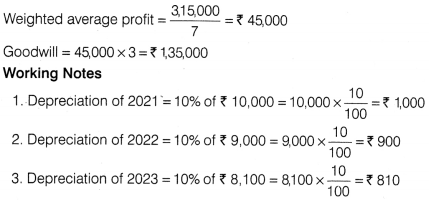
![]()
Question 21.
Atishyokti Ltd. company was registered with an authorised capital of ₹ 20.00.000 divided into 2,00.000 equity shares of ₹ 10 each, payable ₹ 3 on application. ₹ 6 on allotment (including ₹ I premium) and balance on call. The company offered 80,000 shares for public subscription. [4]
All the money has been duly called and received except allotment and call money on 5,000 shares held by Manish and call money on 4.000 shares held by Alok. Manishs shares were forfeited and out of these 3,000 shares were re-issued ₹ 9 per share as Fully paid up. Show share capital in the books of the company. Also prepare notes to accounts.
Answer:
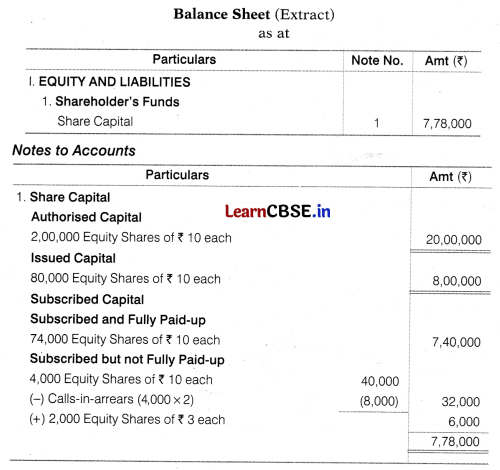
Question 22.
Sun and Kiran are partners sharing profits and losses equally. They decided to dissolve their firm. Assets and liabilities have been transferred lo realisation account. Pass necessary journal entries for the following [4]
Resources:
Free
Resources:
(iv) An outstanding bill for repairs and renewal of ₹ 3,000 was settled through an unrecorded asset which was valued at ₹ 10,000. Balance being settled in cash.
Answer:
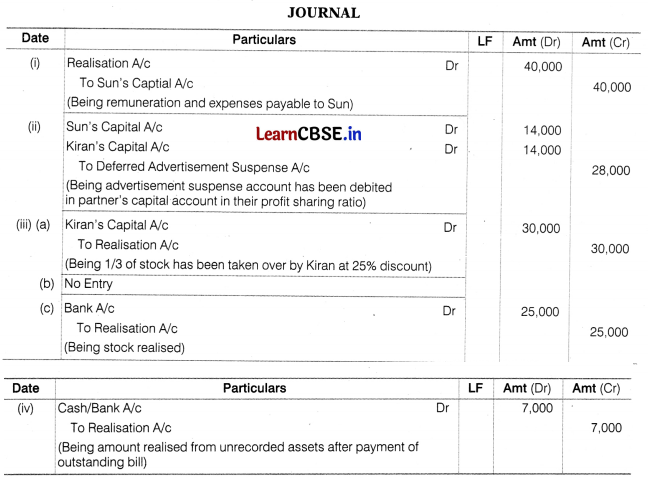

![]()
Question 23.
The Directors of Rockstar Ltd. invited applications for 2,00,000 shares of ₹ 10 each, issued at 20% premium. Share was payable as ₹ 5 on application, ₹ 4 (including premium) on allotment and balance on call. Public had applied for 3,20,000 shares out of which applications for 20,000 shares were rejected and remaining were alloted on pro-rata basis. Simba, an applicant of 15,000 shares failed to pay allotment and call money. His shares were forfeited and out of these 6,000 shares were reissued at a discount of ₹ 2 per share. Journalise. [6]
Or
Shaktimaan Ltd. invited applications for issuing 1,00,000 shares of ₹ 10 each at a premium of ₹ 2 per share. The amount was payable as ₹ 4 on application (including premium), ₹ 5 on allotment and balance on call. Applications were received shares for 1,80,000 of which applications for 30,000 shares were rejected and remaining applicants were allotted on pro-rata basis. Manthan, holding 5,000 shares failed to pay call money and his shares were forfeited. Out of these 2,000 shares were re-issued at a premium of ₹ 3 per share. Prepare cash book and pass necessary entries.
Answer:
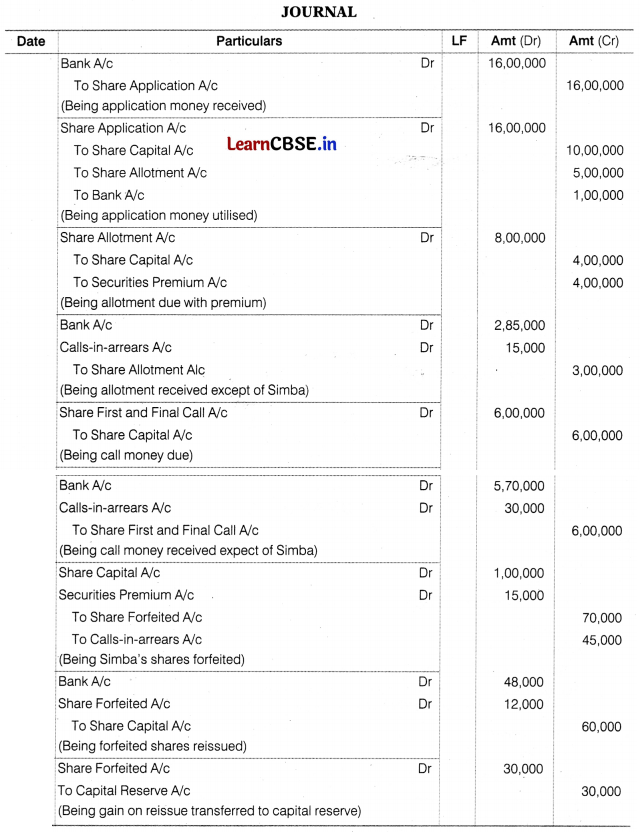
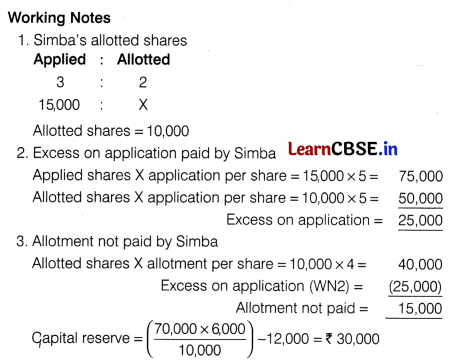
![]()
Or
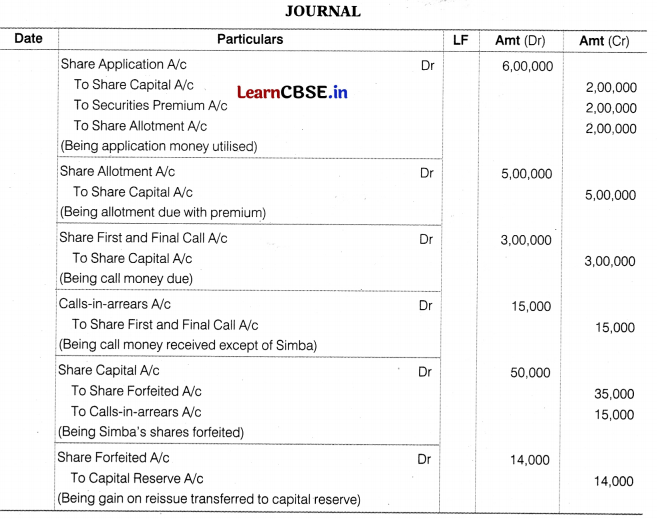

Working Notes
Capital reserve = \(\left(\frac{35,000 x 2,000}{5,000}\right)\) – 0 = ₹ 14,000
Question 24.
Rajinder and Vijay were partners in a firm sharing profits in the ration 3 : 2. On 31st March, 2023 their balance sheet was as follows [6]
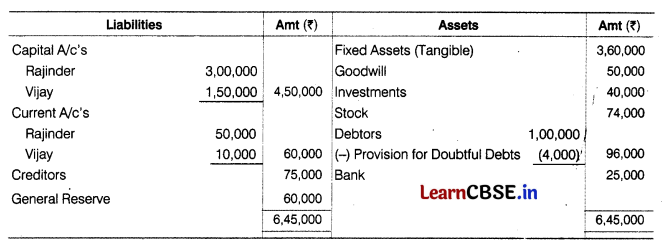
With an aim to expand business it is decided to admit Ranvijay as a partner on 1st April, 2023 on the following terms
(i) Provision for doubtful debts is to be increased to 6% of debtors.
(ii) An outstanding bill for repairs ₹ 50,000 to be accounted in the books.
(iii) An unaccounted interest accrued of ₹ 7500 be provided for.
(iv) Investment were sold at book value.
(v) Half of stock was taken by Rajinder at ₹ 42,000 and remaining stock was also to be revalued at the same rate.
(vi) New profit sharing ratio of partners will be 5: 3: 2.
(vii) Ranvijay will bring ₹ 1,00,000 as capital and his share of goodwill which was valued at twice the average profit of the last three years ended 31st March, 2023, 2022 and 2021 were ₹ 1,50,000, ₹ 1,30,000 and ₹ 1,70,000 respectively. Pass necessary journal entries.
Or
L, M and N were partners in a firm sharing profit and losses in the ratio of 2: 2: 3. On 31st March, 2023, their balance sheet was as follows:
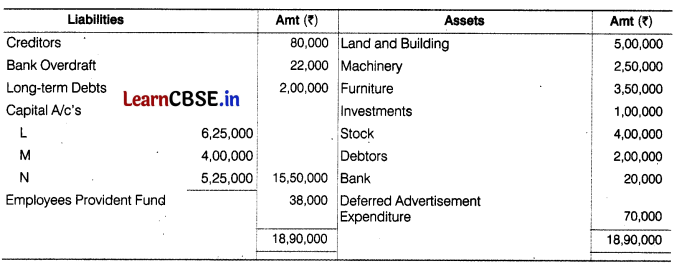
On 31st March, 2023, M retired from the firm and remaining partners decided to carry on business. It was decided to revalue assets and liabilities as under
(i) Land and building be appreciated by ₹ 2,40,000 and machinery be depreciated 10%.
(ii) 50 % of investments were taken by the retiring partner at book value.
(iii) Provision for doubtful debts was to be made at 5 % on debtors.
(iv) Stock will be valued at market price which is ₹ 1,00,000 less than the book value.
(v) Goodwill of the firm be valued at ₹ 5,60,000. L and N decided to share future profits and losses in the ratio of 2:3.
(vi) The total capital of the new firm will be ₹ 32,00,000 which will be in proportion of profit sharing ratio of L and N.
(vii) Gain on revaluation account amounted to ₹ 1,05,000.
Prepare partner’s capital accounts and balance sheet of firm after M’s retirement.
Answer:
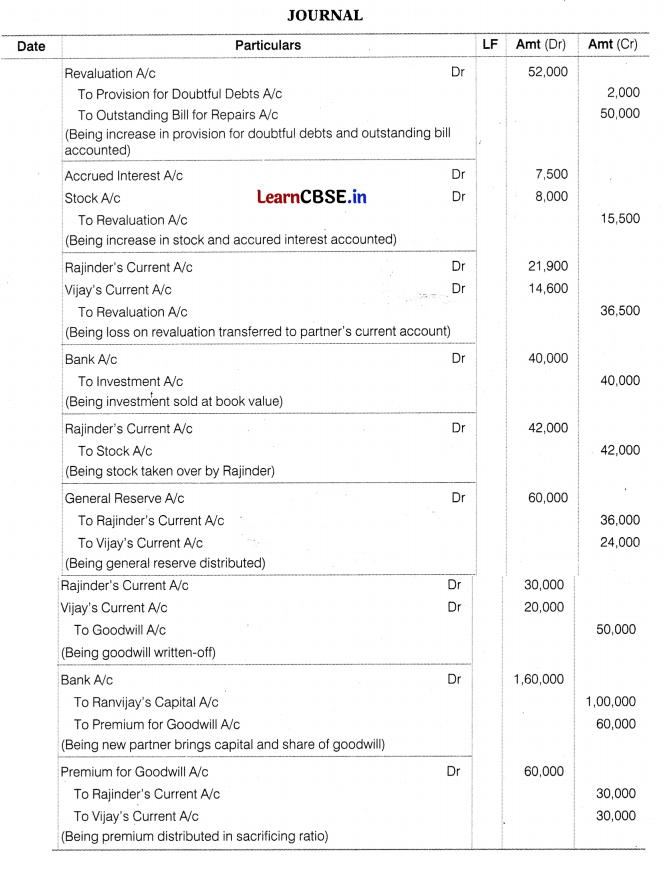
Working Notes
1. Revaluation loss =52,000-15,500=₹ 36,500
2. Ranvijay’s Share of Goodwill
Firm’s goodwill = \(\frac{2 x (1,50,000+1,30,000+1,70,000)}{3}\) = ₹ 3,00,000
Ranvijay’s share of goodwill = \(= 3,00,000 x \frac{1}{5}=₹ 60,000\)
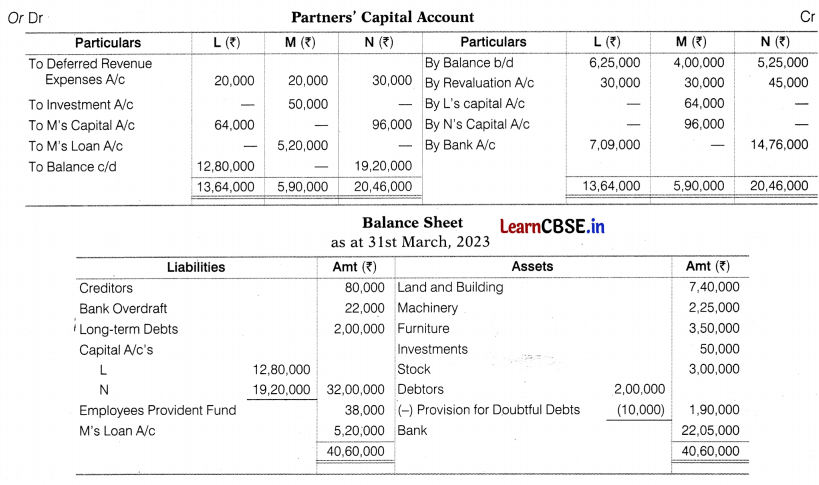 Working Notes
Working Notes
Adjustment of Capital
Total capital of the new firm = ₹ 32,00,000; L’s new capital =32,00,000 x \( \frac{2}{5}\) =₹ 12,80,000 N’s new capital = 32,00,000 x \(\frac{3}{5}\) =₹ 19,20,000
Question 25.
Sandeep, Maheep and Amandeep were partners in a firm sharing profits in the ratio of 2: 2: 1. The firm closes its books on 31 st March, every year. On 30th June, 2020 Maheep died. The partnership deed provided that on the death of a partner his executors will be entitled to the following [6]
(i) Balance in his capital account which amounted to ₹ 1,15,000 and interest on capital till date of death which amounted to ₹ 5,000
(ii) His share in the profits of the firm till the date of his death amounted to ₹ 20,000.
(iii) His share in the goodwill of the firm. The goodwill of the firm on Maheep’s death was valued at ₹ 1,50,000.
(iv) Loan to Maheep amounted ₹ 20,000.
It was agreed that the amount will be paid to his executor in three equal yearly installments with interest @ 10% p.a.
The first installment was to be paid on 30th June, 2021.
Calculate the amount to be transferred to Maheep’s executors account and prepare the executor’s account till it is finally settled. [6]
Answer:
Maheep dues to be transferred to executors = 1,15,000+5,000+20,000+60,000-20,000=₹ 1,80,000
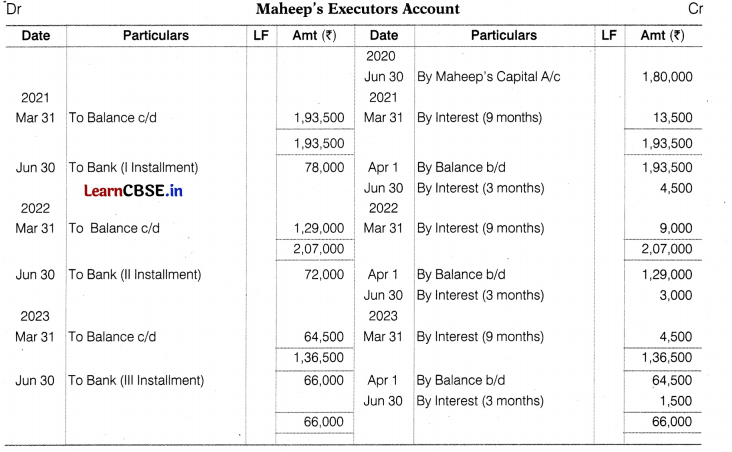
Question 26.
On 1st July, 2022, Panther Ltd. issued 20,000% debentures of ₹ 100 each at 8 % premium and redeemable at a premium of 15 % in four equal installments starting from the end of the third year. [6]
The balance in securities premium on the date of issue of debentures was ₹ 80,000 Interest on debentures was to be paid on 31st March, every year.
Pass journal entries for the financial year 2022-23. Also prepare loss on issue of debentures account.
Answer:
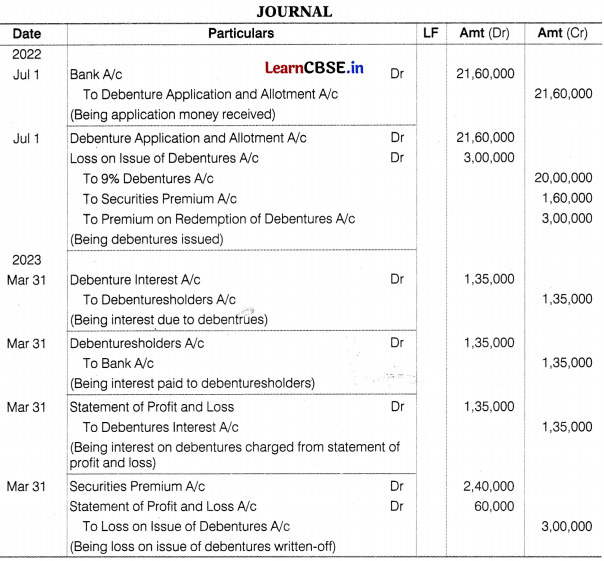

Part B
(Analysis of Financial Statements)
Question 27.
‘Freedom to choose of method of depreciation’ refers to which limitation of financial statement analysis. [1]
(a) Historical analysis
(b) Qualitative aspect ignored
(c) Not free from bias
(d) Ignore price level changes
Answer:
(c) Not free from bias
Or
……………… is included in current assets while preparing balance sheet as per revised Schedule III but excluded from current assets while calculating current ratio.
(a) Debtors
(b) Cash and cash equivalent
(c) Loose tools and stores and spares
(d) Prepaid expense
Answer:
(c) Loose tools are stores and spares
Question 28.
Debt-equity ratio of Dhamaka Ltd is 3: 1. Which of the following will result in decrease in this ratio? [1]
(a) Issue of debentures for cash of ₹ 2,00,000
(b) Issue of debentures of ₹ 3,00,000 to vendors from whom machinary was purchased
(c) Goods purchased on credit of ₹ 1,00,000
(d) Issue of equity shares of ₹ 2,00,000
Answer:
(d) Issue of equity shares will increase the equity of the company and debt remains unchanged.
Question 29.
Statement I Sale of marketable securities will result in no flow of cash. [1]
Statement II Debentures issued as collateral security will result in inflow of cash.
Alternatives
(a) Both statements are correct
(b) Both statements are incorrect
(c) Statement I is correct and Statement II is incorrect
(d) Statement I is incorrect and Statement I is correct
Answer:
(c) Debentures issued as collateral security will result in no flow.
Or
What will be the effect of issue of bonus shares on cash flow statement?
(a) No effect
(b) Inflow in financing activity
(c) Inflow in operating activity
(d) Inflow in investing activity
Answer:
(a) No effect
Question 30.
Aditya Sunrise Ltd. provides you the following information [1]

Additional Information
(i) Equity share capital raised during the year ₹ 3,00,000.
(ii) 10% bank loan was repaid on 1 st April, 2022.
(iii) Dividend received during the year was ₹ 20,000.
(iv) Dividend proposed for the year 2021-22 was ₹ 50,000 but only ₹ 20,000 was approved by the shareholders.
Find out the cash flow from financing activities.
(a) 1,50,000
(b) 2,00,000
(c) 1,70,000
(d) 1,80,000
Answer:

Question 31.
Classify the following items under major heads and sub-heads (If any) in the balance sheet of a company as per Schedule III of the Companies Act, 2013. [3]
(i) Loose tools
(ii) Loan repayable on demand
(iii) Provision for retirement benefits
(iv) Prepaid insurance
(v) Capital advances
(vi) Shares in listed companies
Answer:

Question 32.
(i) A company had a liquid ratio of 1.5 and current ratio of 2 and inventory turnover ratio 6 times. It had total current assets of 8,00,000. Find out annual sales if goods are sold at 25% profit on cost. [3]
(ii) Calculate debt to capital employed ratio from the following information
Shareholder funds —- 15,00,000 8%
Debenture —- 7,50,000
Current liabilities —- 2,50,000
Non-current assets —- 17,50,000
Current assets —- 7,50,000
Answer:
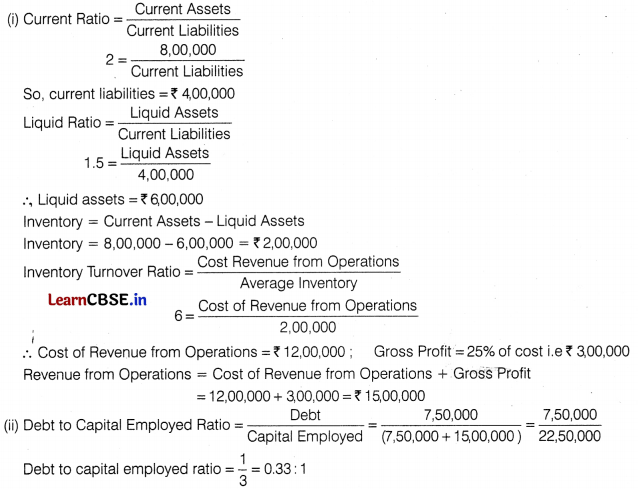
Question 33.
From the information extracted from the statement of profit and loss of Zee Ltd for the year ended 31st March, 2022 and 31st March, 2023, prepare a common size statement of profit and loss. [4]

Or
From the following information, prepare comparative statement of profit and loss
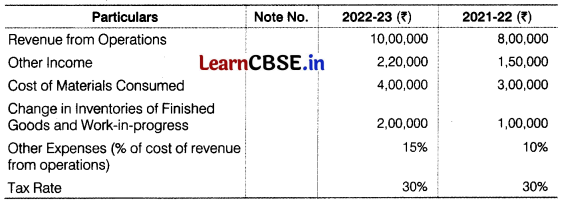
Answer:
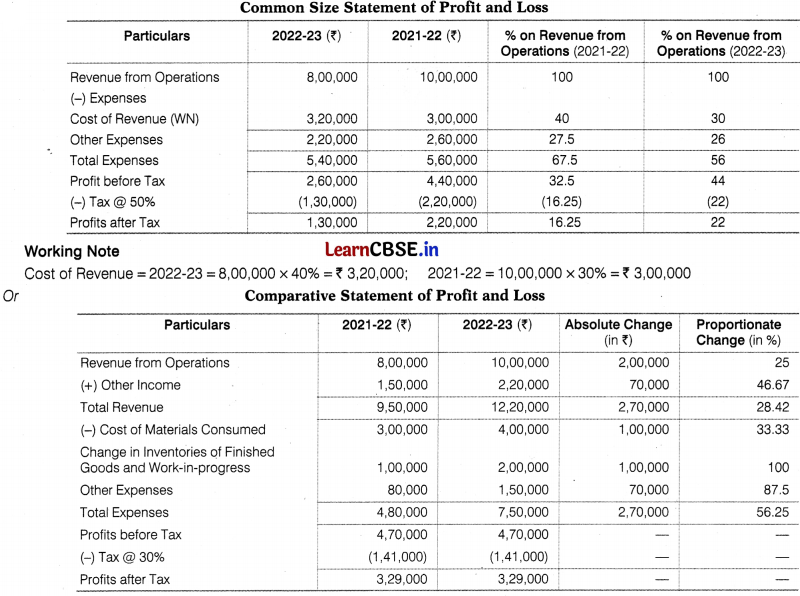
Question 34.
Prepare a cash flow statement from the following balance sheets of Arya Ltd. [6]
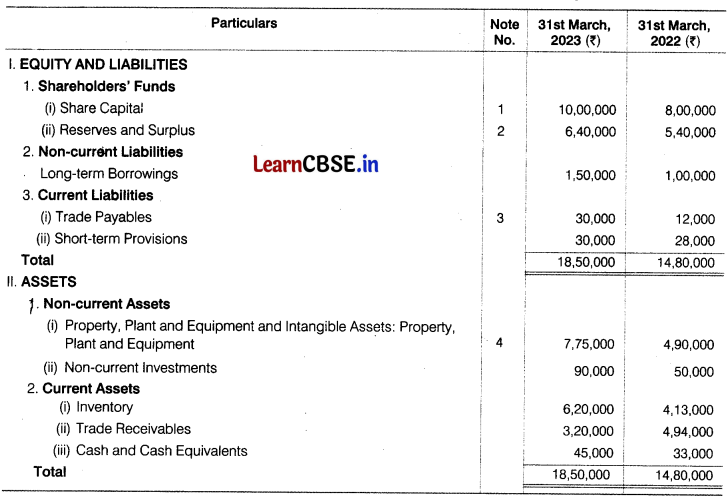
Notes to Accounts:
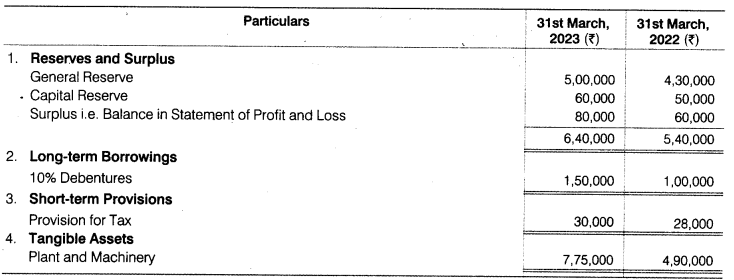
Additional Information:
(i) Tax provided during the year is ₹ 17,000.
(ii) Depreciation charged on plant and machinery during the year amounted to ₹ 1,20,000.
(iii) Non-current investments costing ₹ 30,000 were sold for ₹ 40,000 during the year. Gain on sale
of investments was credited to capital reserve.
(iv) Additional debentures were issued on 31st March, 2023.
Answer:
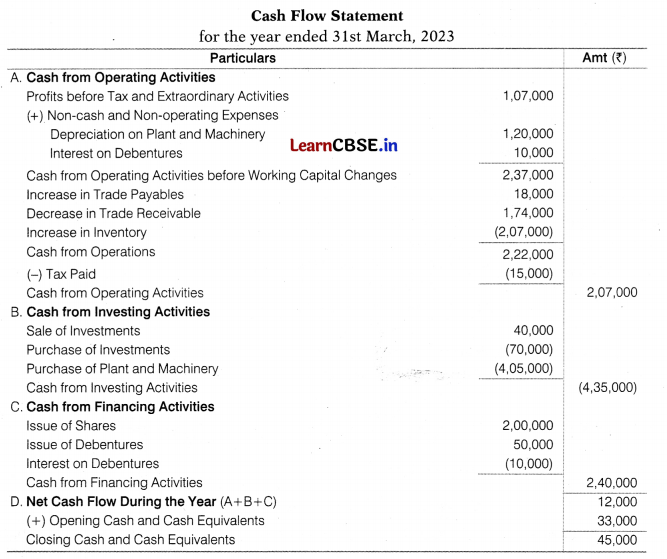
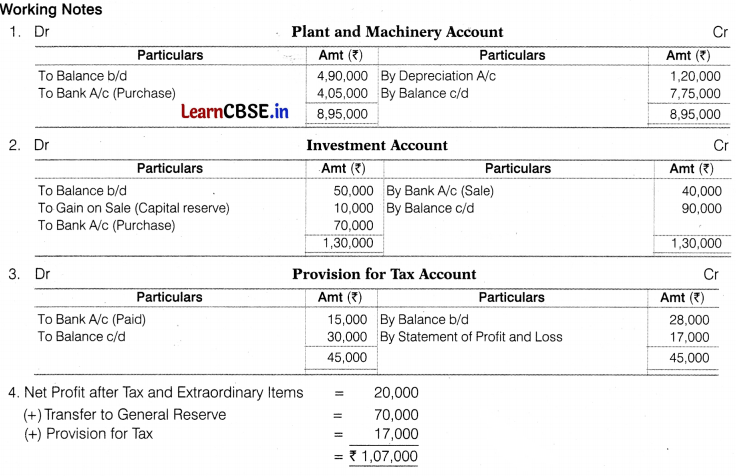
Free
Resources:
Free
Resources: